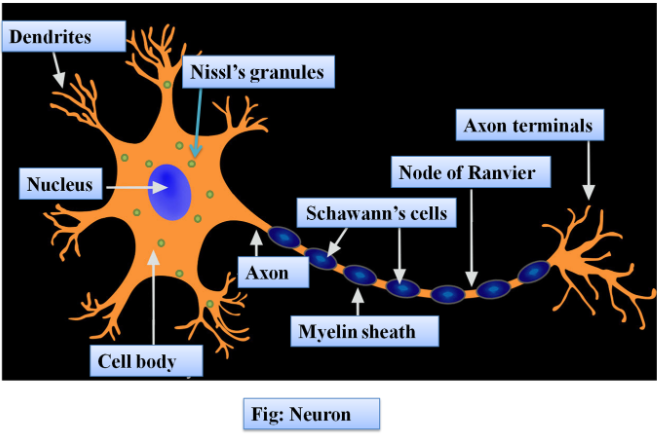
Name the location of Nissl’s granules.
Answer
471.6k+ views
Hint: The presence of Nissl’s granules is a characteristic feature of the type of cells that forms a system for integration and coordination among different organs in the body of animals.
Complete answer:
The Presence of Nissl’s granules is a characteristic feature of all neurons. They are located in the cytoplasm of neurons. More specifically, they are confined to the dendrites and soma or cell body of the neurons. They are absent in the axon's part of neurons. Nissl’s granules are uneven masses of rough endoplasmic reticulum with numerous attached and free ribosomes. Specifically, Nissl’s granules are concerned with the production of proteins necessary for the structural maintenance of neurons or their metabolism. Also, many proteinaceous neurotransmitters are synthesized by Nissl’s granules.
Additional Information:
Neural or nervous tissue is composed of neurons which are the longest cells in our body. About 100 billion neurons are found in the human neural system, the majority of which occurs in our brain. A neuron consists of the main cell body and many cytoplasmic processes or extensions arising from it.
Cell body: It is also known as soma or cyton. It is normally oval or spherical. Like any normal cell, it consists of cytoplasm or neuroplasm, nucleus and cell membrane. Organelles such as Golgi apparatus and lysosomes are suspended in it along with the neurofibrils, neurotubules and Nissl’s granules.
Neurofibrils play an important role in the transmission of impulses or electric signals and extend from dendrites to axon cylinders to the nerve endings. Neurotubules have the job to maintain the proper shape of the neuron. Most neurons have two kinds of processes: multiple dendrites and a single axon.
Dendrites: They are usually shorter, tapering and highly branched. They may be one to several. They are the receiving segments of a neuron and thus contain various sites for binding chemical messengers from other cells. Their cytoplasm contains Nissl's bodies, mitochondria and other organelles.
Axon: An axon is a long, thin, cylindrical portion that propagates the nerve impulse to another neuron, muscle fibre or a gland cell. The part of cyton from where the axon originates is referred to as axon hillock.
Note: Nissl’s granules are absent in the axon and thus the protein synthesis does not occur in the axon. They have to depend on the cell body for the supply of proteins. Neurons are of two types namely myelinated and unmyelinated neurons. Myelin sheath is present in myelinated neurons and accounts for the greater speed of impulse travelling along an axon.

Complete answer:
The Presence of Nissl’s granules is a characteristic feature of all neurons. They are located in the cytoplasm of neurons. More specifically, they are confined to the dendrites and soma or cell body of the neurons. They are absent in the axon's part of neurons. Nissl’s granules are uneven masses of rough endoplasmic reticulum with numerous attached and free ribosomes. Specifically, Nissl’s granules are concerned with the production of proteins necessary for the structural maintenance of neurons or their metabolism. Also, many proteinaceous neurotransmitters are synthesized by Nissl’s granules.
Additional Information:
Neural or nervous tissue is composed of neurons which are the longest cells in our body. About 100 billion neurons are found in the human neural system, the majority of which occurs in our brain. A neuron consists of the main cell body and many cytoplasmic processes or extensions arising from it.
Cell body: It is also known as soma or cyton. It is normally oval or spherical. Like any normal cell, it consists of cytoplasm or neuroplasm, nucleus and cell membrane. Organelles such as Golgi apparatus and lysosomes are suspended in it along with the neurofibrils, neurotubules and Nissl’s granules.
Neurofibrils play an important role in the transmission of impulses or electric signals and extend from dendrites to axon cylinders to the nerve endings. Neurotubules have the job to maintain the proper shape of the neuron. Most neurons have two kinds of processes: multiple dendrites and a single axon.
Dendrites: They are usually shorter, tapering and highly branched. They may be one to several. They are the receiving segments of a neuron and thus contain various sites for binding chemical messengers from other cells. Their cytoplasm contains Nissl's bodies, mitochondria and other organelles.
Axon: An axon is a long, thin, cylindrical portion that propagates the nerve impulse to another neuron, muscle fibre or a gland cell. The part of cyton from where the axon originates is referred to as axon hillock.
Note: Nissl’s granules are absent in the axon and thus the protein synthesis does not occur in the axon. They have to depend on the cell body for the supply of proteins. Neurons are of two types namely myelinated and unmyelinated neurons. Myelin sheath is present in myelinated neurons and accounts for the greater speed of impulse travelling along an axon.

Recently Updated Pages
Master Class 11 English: Engaging Questions & Answers for Success

Master Class 11 Computer Science: Engaging Questions & Answers for Success

Master Class 11 Maths: Engaging Questions & Answers for Success

Master Class 11 Social Science: Engaging Questions & Answers for Success

Master Class 11 Economics: Engaging Questions & Answers for Success

Master Class 11 Business Studies: Engaging Questions & Answers for Success

Trending doubts
One Metric ton is equal to kg A 10000 B 1000 C 100 class 11 physics CBSE

The sequence of spore production in Puccinia wheat class 11 biology CBSE

Petromyzon belongs to class A Osteichthyes B Chondrichthyes class 11 biology CBSE

Comparative account of the alimentary canal and digestive class 11 biology CBSE

Lassaignes test for the detection of nitrogen will class 11 chemistry CBSE

The type of inflorescence in Tulsi a Cyanthium b Hypanthodium class 11 biology CBSE




